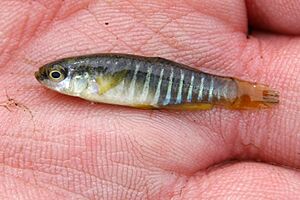Mediterranean killifish facts for kids
The Mediterranean killifish, also known as the Mediterranean banded killifish or South European toothcarp (Aphanius fasciatus), is a small type of fish. It belongs to the Cyprinodontidae family, which includes many "toothcarp" species. These fish are known for living in a variety of water conditions, especially salty or brackish waters.
Quick facts for kids Mediterranean killifish |
|
|---|---|
 |
|
| Conservation status | |
| Scientific classification | |
| Synonyms | |
|
Contents
About the Mediterranean Killifish
The Mediterranean killifish is a small, hardy fish. It can live in very salty water. This makes it special among fish species. Its scientific name, Aphanius fasciatus, was given by Valenciennes in 1821.
Where They Live
This fish is found in many countries around the Mediterranean Sea. It lives in places like Albania, Algeria, Bosnia and Herzegovina, Croatia, Cyprus, Egypt, France, Greece, Israel, Italy, Lebanon, Libya, Malta, Morocco, Montenegro, Slovenia, Syria, Tunisia, and Turkey.
Their Natural Homes
Mediterranean killifish prefer specific types of homes. They live in saline lakes, which are lakes with high salt content. They also live in saline marshes, which are wet, grassy areas near the coast. Another common habitat is coastal saline lagoons. These are shallow bodies of water separated from the sea by sandbars.
What They Look Like
Mediterranean killifish are usually small. They have a body shape that helps them move easily through shallow waters. Males and females often look a bit different. Males might have brighter colors or more distinct patterns. This helps them attract mates during breeding season.
Life Cycle and Reproduction
These fish lay eggs to reproduce. They usually breed in warmer months. The eggs hatch into tiny fish called fry. The fry grow quickly in their salty environments.
Adapting to Salty Water
One amazing thing about the Mediterranean killifish is its ability to live in very salty water. Most fish cannot survive in such conditions. This fish has special ways to handle the salt. It can keep its body's salt levels balanced. This adaptation allows it to thrive where other fish cannot.


